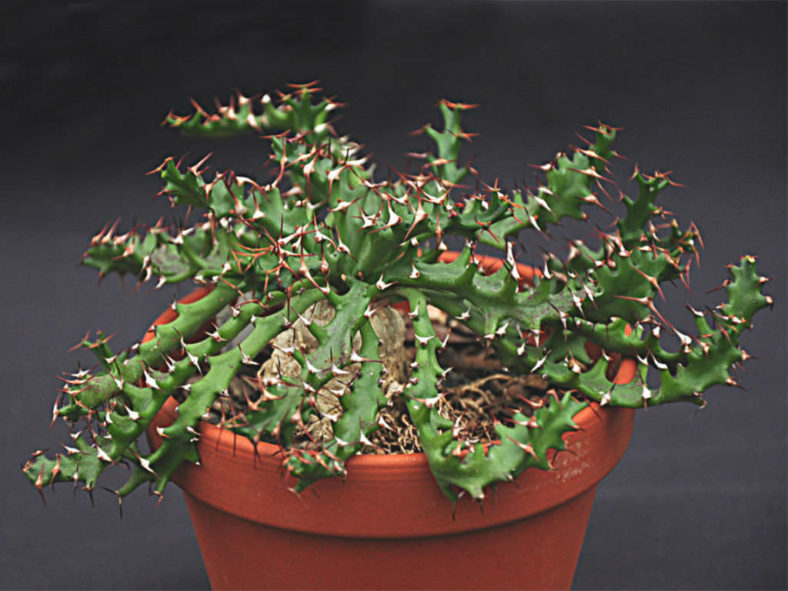Scientific Name
Euphorbia squarrosa Haw.
Scientific Classification
Family: Euphorbiaceae
Subfamily: Euphorbioideae
Tribe: Euphorbieae
Subtribe: Euphorbiinae
Genus: Euphorbia
Etymology
The specific epithet "squarrosa" (pronounced "skwa-RO-suh") means "squarrose, scurfy, scabby" and probably refers to the surface of the stems of this species, which is rough due to the notched ribs between the pairs of spines.
Origin
Euphorbia squarrosa is native to South Africa (Eastern Cape). It is not accepted as a separate species and is treated as a synonym of Euphorbia stellata subsp. stellata.
Description
Euphorbia squarrosa is a spiny succulent with a swollen rootstock that extends into a caudex, from the top of which arise many branches in all directions. It can grow up to 12 inches (30 cm) tall, while the caudex can reach a length of 25 inches (50 cm) and a diameter of 4 inches (10 cm). The branches are dark green with grayish spines, creeping or semi-erect, typically 3-angled and slightly twisted. They can grow up to 8 inches (20 cm) in height and 1 inch (2.5 cm) in width. The spines are initially reddish-brown, turning gray as they age, and can measure up to 0.25 inches (0.6 cm) in length. They arranged in pairs on either side of a roughly circular shield of the same color, aligned along the ribs of the branches. The tiny triangular leaves fall off shortly after they appear.
Flowering occurs during the day, typically in late spring and summer. The inflorescences are solitary and arise from the notches of the ribs of the branches. They have a reddish cyathium, which can reach a diameter of up to 0.2 inches (0.5 cm), and oblong, green to orange nectaries that touch each other.

How to Grow and Care for Euphorbia squarrosa
Hardiness: USDA hardiness zones 9b to 11b: from 25°F (-3.9°C) to 50°F (10°C).
Euphorbias are very easy to care for. These plants require a little pampering to become established, but once they are, they are self-sufficient. More die from overcare and watering than from neglect. Euphorbias need well-draining soil and ample sunlight. They are not particular about soil pH but cannot tolerate wet soil. Unlike most succulents, Euphorbia does not handle long periods of drought well. It may need weekly watering during the summer. Water whenever the top several inches of the soil are dry. Water deeply, but avoid letting them sit in wet soil, as this can cause root rot. Add some organic matter or fertilizer to the planting hole. Feed with a half-strength fertilizer monthly if you are growing them in containers or your soil is poor.
These succulents can be grown from seed, but they can be difficult to germinate (or even find). They are usually propagated by cuttings. This can be tricky because of the exuding sap. Rooting hormone is recommended with Euphorbias. They tend to grow problem-free, but there are a few pests and diseases to be alert for.
Learn more at How to Grow and Care for Euphorbia.
Links
- Back to genus Euphorbia
- Succupedia: Browse succulents by Scientific Name, Common Name, Genus, Family, USDA Hardiness Zone, Origin, or cacti by Genus
Photo Gallery
Click on a photo to see a larger version.


